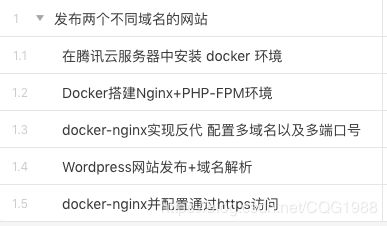docker nginx实现一个主机部署多个站点
用户故事:发布两个网站
现状:只有一个云服务器(不想多买)
任务:
1.使用php-fpm镜像开启php-fpm应用容器
拉取php-fpm镜像:
sudo docker pull bitnami/php-fpm先运行,创建container,copy配置文件(也可不用)
sudo docker run -d --rm --name myFpm bitnami/php-fpmsudo docker cp myFpm:/opt/bitnami/php /home/ubuntu/share/php-fpmTip: --rm 参数,当容器停止后自动删除。
创建php-fpm容器:
sudo docker run -d --name myFpm -v /var/www/html:/usr/share/nginx/html -v /home/ubuntu/share/php-fpm/php:/opt/bitnami/php bitnami/php-fpm其中/var/www/html是宿主机存放站点文件的路径(自定义的),/usr/share/nginx/html是为nginx服务器项目默认的路径。
Tip: -d : 该参数为后台运行之意
-v : 指定宿主机与容器的映射关系
2.使用nginx:alpine镜像开启nginx应用容器
拉取nginx:alpine镜像:
sudo docker pull nginx:alpine先运行,创建container,copy配置文件
sudo docker run --rm -d --name myNginx nginx:alpine复制配置文件
sudo docker cp myNginx:/etc/nginx/nginx.conf /home/ubuntu/share/nginx/conf其中/etc/nginx/nginx.conf是nginx中默认的配置文件,/home/ubuntu/share/nginx/conf宿主机文件路径(自定义的)
做之前只复制了这个文件,后面在操作的时候,其实还需要操作nginx容器中/etc/nginx/conf.d/default.conf配置文件
当然后面用了一个笨办法,在宿主机上编辑好,接着copy到docker 容器中:
sudo docker cp default.conf myNginx:/etc/nginx/conf.d/default.conf下面启动docker nginx容器:
sudo docker run -d --name myNginx -p 80:80 -v /var/www/html:/usr/share/nginx/html -v /home/ubuntu/share/nginx/conf/nginx.conf:/etc/nginx/nginx.conf nginx:alpine其中/var/www/html是宿主机存放站点文件的路径(自定义的),/usr/share/nginx/html是为nginx服务器项目默认的路径。
3. 查看容器是否都正常启动
sudo docker ps4. 配置nginx
查看php-fpm的IP信息
sudo docker inspect myFpm | grep "IPAddress"结果(这里引用了网络上的一个结果,当然我也得到了同样的结果,这里实在不想再去截图了^_^)
由此得到了php-fpm容器的Ip地址,接着修改nginx中的default.conf文件
server {
listen 80;
server_name localhost;
#charset koi8-r;
#access_log /var/log/nginx/host.access.log main;
location / {
root /usr/share/nginx/html;
index index.html index.htm index.php;
}
#error_page 404 /404.html;
# redirect server error pages to the static page /50x.html
#
error_page 500 502 503 504 /50x.html;
location = /50x.html {
root /usr/share/nginx/html;
}
# proxy the PHP scripts to Apache listening on 127.0.0.1:80
#
#location ~ \.php$ {
# proxy_pass http://127.0.0.1;
#}
# pass the PHP scripts to FastCGI server listening on 127.0.0.1:9000
#
location ~ \.php$ {
root html;
fastcgi_pass 172.17.0.2:9000;
fastcgi_index index.php;
fastcgi_param SCRIPT_FILENAME /usr/share/nginx/html/$fastcgi_script_name;
include fastcgi_params;
}
# deny access to .htaccess files, if Apache's document root
# concurs with nginx's one
#
#location ~ /\.ht {
# deny all;
#}
}
这里要注意fastcgi_pass和fastcgi_param这两个参数,其中fastcgi_pass用的就是php-fpm的ip和服务的端口172.17.0.2:9000,
fastcgi_param我是参考这个帖子中的设置的,还是很感谢这么多的大神的无私分享:
下面是我的nginx.conf文件:
user root;
worker_processes 1;
error_log /var/log/nginx/error.log warn;
pid /var/run/nginx.pid;
events {
worker_connections 1024;
}
http {
include /etc/nginx/mime.types;
default_type application/octet-stream;
log_format main '$remote_addr - $remote_user [$time_local] "$request" '
'$status $body_bytes_sent "$http_referer" '
'"$http_user_agent" "$http_x_forwarded_for"';
access_log /var/log/nginx/access.log main;
sendfile on;
#tcp_nopush on;
keepalive_timeout 65;
#gzip on;
include /etc/nginx/conf.d/*.conf;
}其中user 参数,我改成了root,这个要参考你发布站点路径的权限,一定要注意。
当然这些都做好了之后,我用index.php测试的时候,还是遇到了403forbidden的错误,排查了很久,发现实在default.conf里面的index参数中我没有添加 index.php,添加后一切正常。具体会引发nginx 403 forbidden的原因还有很多,如果想了解更多可以看下这个帖子。
记得重启nginx!!!!!!!!!!!!!!
5.多站点配置
这里参考了很多帖子,有些帖子是利用nginx的代理,还在研究,比如有这么配置的:
worker_processes 1;
events {
worker_connections 1024;
}
http {
include mime.types;
default_type application/octet-stream;
sendfile on;
keepalive_timeout 65;
server
{
listen 80;
server_name www.dcssn.com;
location / {
proxy_redirect off;
proxy_set_header Host $host;
proxy_set_header X-Real-IP $remote_addr;
proxy_set_header X-Forwarded-For $proxy_add_x_forwarded_for;
proxy_pass http://47.92.69.112:8080;
}
}
server
{
listen 80;
server_name www.xhxf119.com;
location / {
proxy_redirect off;
proxy_set_header Host $host;
proxy_set_header X-Real-IP $remote_addr;
proxy_set_header X-Forwarded-For $proxy_add_x_forwarded_for;
proxy_pass http://47.92.69.112:8081;
}
}
}我这里是参考的这种配置,我觉得前期实现相对简单些:
# 向配置目录添加如下两个配置并建立相应目录和测试的index.html文件,
#向host文件添加web1.com和web2.com两个域名
# conf1.conf
server {
listen 80;
server_name web1.com;
location / {
root /usr/share/nginx/html/web1;
index index.html index.htm;
}
}
# conf2.conf
server {
listen 80;
server_name web2.com;
location / {
root /usr/share/nginx/html/web2;
index index.html index.htm;
}
}
# 如果要添加php脚本请添加如下,注意fastcgi_pass必须是php的inspect的ip信息,
#注意修改SCRIPT_FILENAME目录路径
location ~ \.php$ {
fastcgi_pass 172.17.0.2:9000;
fastcgi_index index.php;
fastcgi_param SCRIPT_FILENAME /usr/share/nginx/html$fastcgi_script_name;
fastcgi_param SCRIPT_NAME $fastcgi_script_name;
include fastcgi_params;
}
下面是我自己的其中的一个站点的配置:
server {
listen 80;
server_name www.XXXXXXX.com;
location / {
root /usr/share/nginx/html/XXXXXX.com;
index index.html index.php;
}
location ~ \.php$ {
fastcgi_pass 172.17.0.2:9000;
fastcgi_index index.php;
fastcgi_param SCRIPT_FILENAME /usr/share/nginx/html/XXXXXX.com$fastcgi_script_name;
fastcgi_param SCRIPT_NAME $fastcgi_script_name;
include fastcgi_params;
}
}至于另一种多站点的方式,后面再做研究吧 ~ 还希望能接着配置https,加油!fighting!!!!




